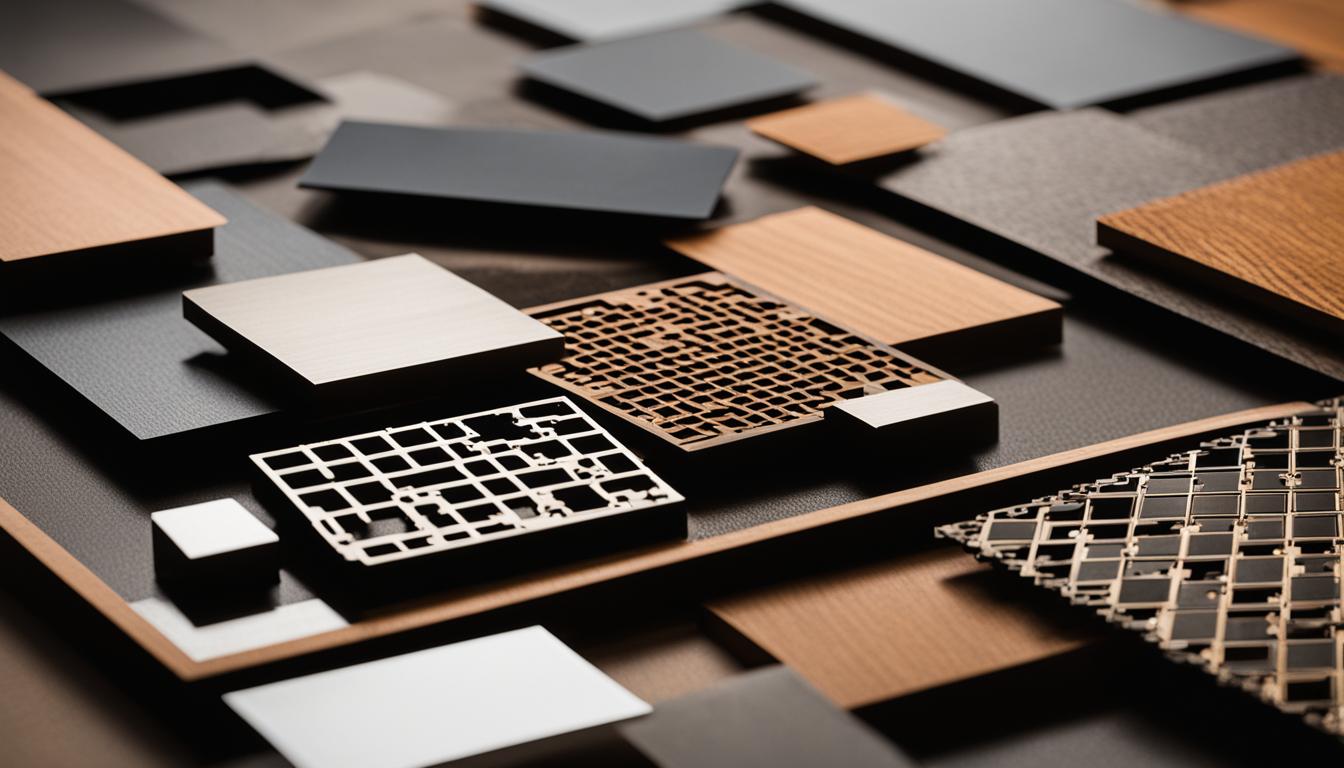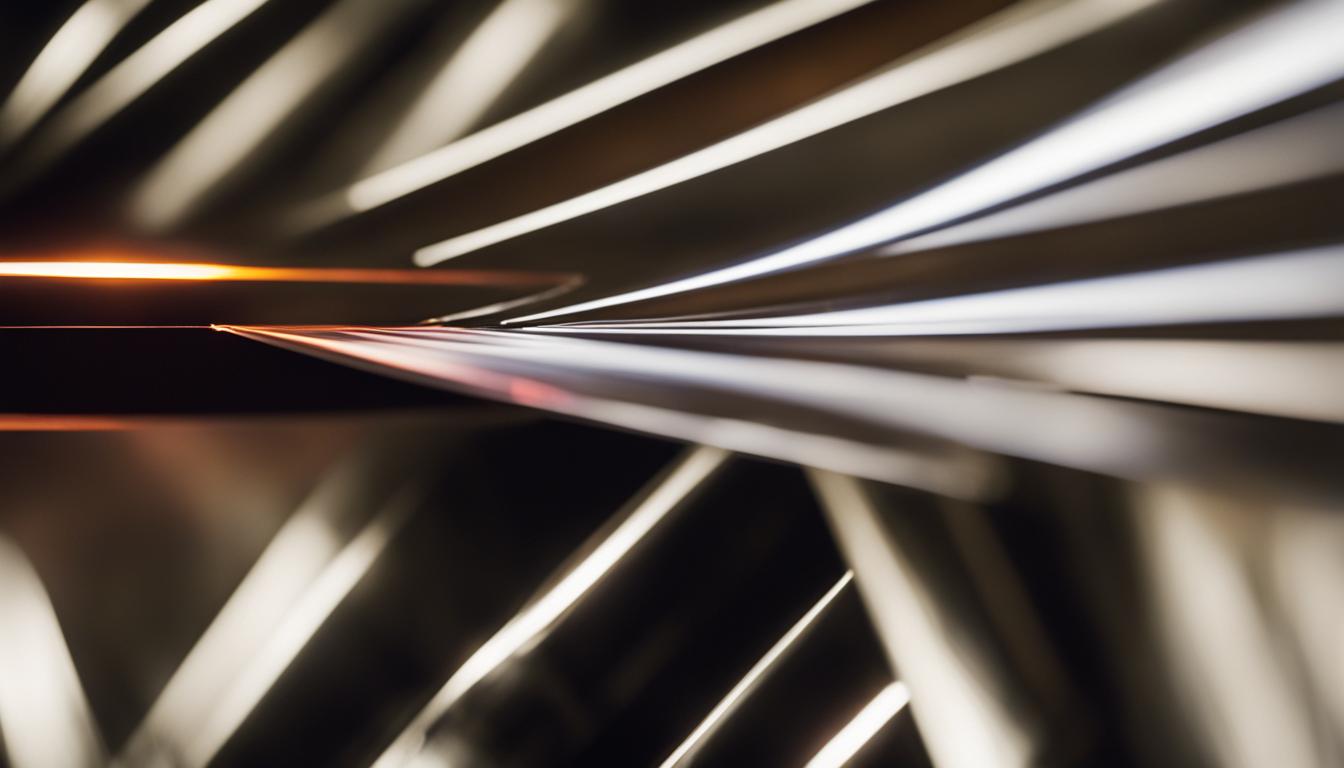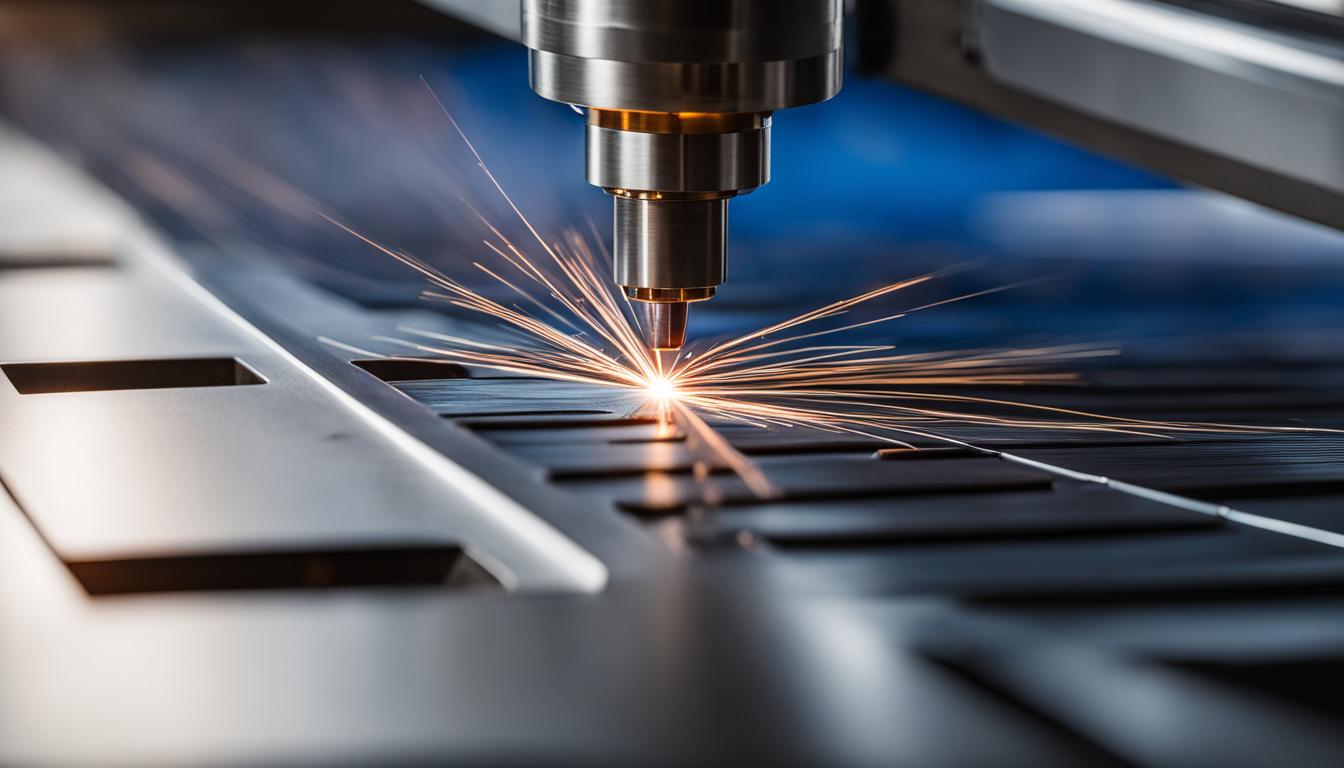Laser cutting is a revolutionary technology that has transformed various industries, offering remarkable precision, speed, and versatility. But how does laser cutting work, and what is the laser cutting process? In this section, we will explore the fundamentals of laser cutting technology and shed light on its fascinating operation.
The laser cutting process involves the use of a highly concentrated laser beam to heat and vaporize or melt the surface of a material. This focused laser beam follows a selected geometry, accurately separating the material and creating clean, precise cuts. Laser cutting can be performed on a wide range of materials, including plastics, metals, and food products, making it incredibly versatile.
One of the key advantages of laser cutting is its ability to cut intricate and fine geometries without the need for post-processing. The laser’s high accuracy ensures that the resulting cut is incredibly precise, with minimal deviation. Additionally, laser cutting eliminates the issue of tool wear, as it is a non-contact cutting method, further enhancing its efficiency and accuracy.
Now that we have gained a general understanding of how laser cutting works, let’s explore the laser cutting procedure in more detail in the next section.
- Laser cutting utilizes a concentrated laser beam to heat and vaporize or melt the surface of a material.
- The laser beam follows a selected geometry to accurately separate the material, allowing for precise cuts.
- Laser cutting offers the advantage of cutting fine geometries without the need for post-processing.
- There is no tool wear involved in laser cutting, making it highly efficient and accurate.
- Laser cutting is suitable for various materials, including plastics, metals, and food products.
Laser Cutting Procedure Explained Technically
Laser cutting is a precise and efficient thermal separation process that utilizes a high-powered laser beam to heat the material being cut. The heat generated by the laser beam causes the material to either melt or vaporize, allowing for precise and clean cuts to be made.
To initiate the cutting process, the laser beam penetrates the material following a selected geometry. This ensures that the desired shape and dimensions are achieved with accuracy. Depending on the specific application, the use of process gases, such as oxygen or nitrogen, can enhance the cutting results by improving the quality of the cut edges.
One of the key advantages of laser cutting is its ability to achieve high levels of accuracy. The resulting cut, known as the kerf, is barely larger than the diameter of the laser beam itself. This allows for the cutting of fine geometries and intricate shapes with precision. Laser cutting eliminates the need for post-processing in many cases, reducing both time and cost.
Laser cutting also offers the advantage of minimal tool wear. Unlike traditional cutting processes that rely on mechanical tools, laser cutting does not involve physical contact with the material, which reduces the likelihood of tool damage or wear. This further contributes to cost savings in ongoing operation.
Overall, the laser cutting procedure is a highly efficient and accurate method of cutting a wide range of materials. Its technical process, combined with its numerous benefits, makes it a popular choice in various industries, including manufacturing, automotive, aerospace, and more.
Advantages of Laser Cutting
Laser cutting offers numerous benefits that make it a preferred cutting process in various industries. Whether cutting organic or inorganic materials, laser cutting provides several advantages over other methods. Some key advantages of laser cutting include:
No Post-Processing Required
Laser cutting often eliminates the need for post-processing, saving both time and cost. The intense heat generated by the laser beam seals the edges of the material, preventing unraveling and reducing the need for additional finishing processes.
Precision and Accuracy
Laser cutting provides exceptional accuracy, allowing for the cutting of intricate and fine geometries. The focused laser beam can achieve precision up to 10 micrometers, ensuring precise cuts with minimal deviation. This level of precision makes laser cutting ideal for industries that require high-quality, intricate designs.
Wide Range of Compatible Materials
One of the major advantages of laser cutting is its ability to cut a wide range of materials. From plastics and metals to fabrics and foams, laser cutting can handle various materials, both organic and inorganic. This versatility makes laser cutting a go-to option for industries that work with diverse materials.
No Tool Wear
Laser cutting machines do not rely on physical tools that can wear out over time. Unlike mechanical cutting methods, laser cutting ensures consistent cutting quality without the need for sharpening or replacing tools. This not only saves costs on tool maintenance but also ensures consistent cutting results throughout the machine’s lifespan.
In summary, laser cutting offers numerous advantages, including no post-processing requirements, high precision, versatility with materials, and a prolonged machine lifespan without the need for tool replacement. These advantages make laser cutting a reliable and cost-effective cutting solution for various industries.
Comparison of Laser Cutting with Other Cutting Processes
Laser cutting technology has revolutionized the cutting industry with its precision and versatility. When comparing laser cutting with other cutting processes, such as plasma cutting and mechanical cutting, several factors come into play.
Laser cutting vs Plasma cutting:
Plasma cutting is a popular choice for cutting electrically conductive materials due to its flexibility. However, laser cutting outshines plasma cutting in various ways:
- Higher cut quality: Laser cutting produces superior cut quality, delivering clean edges and minimal distortion.
- Lower energy consumption: Laser cutting consumes less energy, making it a more efficient and cost-effective option.
- Reduced dust creation: Unlike plasma cutting, laser cutting generates minimal dust, ensuring a cleaner working environment.
- Lower noise emissions: Laser cutting operates with reduced noise levels, providing a quieter and more comfortable working environment.
Laser cutting vs Mechanical cutting:
Comparing laser cutting with mechanical cutting processes reveals several advantages in favor of laser cutting:
- Non-contact processing: Laser cutting requires no physical contact with the material, minimizing the risk of damage and wear.
- Reduced setup costs: Laser cutting eliminates the need for complex tooling and setup, saving time and resources.
- Lower contamination: Laser cutting produces minimal debris and reduces the chances of contamination compared to mechanical cutting methods.
- Higher flexibility in processing: Laser cutting can handle a broader range of materials and offers more flexibility in intricate cutting tasks.
When choosing between laser cutting and other methods, it is essential to consider the specific requirements of the material and application. Laser cutting shines in terms of cut quality, energy efficiency, cleanliness, and noise reduction, making it a preferred choice for many industries.
Materials Compatible with Laser Cutting
Laser cutting is a highly versatile technology that allows for the precise cutting of a wide range of materials. Whether it’s plastics, metals, or even organic materials, laser cutting can handle them all with ease. Here are some of the common materials that are compatible with laser cutting:
| Material | Description |
|---|---|
| Plastics | Including ABS and PET, laser cutting can easily cut through various types of plastic materials. |
| Metals | From thin metal foils to thicker metal sheets, laser cutting can handle a wide range of metal materials. |
| Acrylic | This transparent plastic material is commonly used in signage, displays, and various other applications. |
| Wood | Laser cutting provides precise and intricate cuts on different types of wood, making it ideal for various woodworking projects. |
| Paper | From delicate designs to complex patterns, laser cutting can create intricate cuts on paper without tearing or damaging the material. |
| Rubber | Whether it’s natural rubber or synthetic rubber, laser cutting can easily cut through this elastic material. |
| Leather | Laser cutting is widely used in the fashion industry to create precise and intricate cuts on leather materials. |
| Fabric | From cotton to silk, laser cutting can provide precise cuts on different types of fabrics without fraying or unraveling the edges. |
| Foam | Laser cutting is commonly used in packaging and foam fabrication, providing clean and precise cuts on foam materials. |
| Cardboard | Whether it’s for prototyping or packaging, laser cutting can easily cut through cardboard materials, creating intricate designs or custom shapes. |

The ability to process such a diverse range of materials is one of the key advantages of laser cutting technology. Whether you’re in the manufacturing industry, fashion industry, or involved in any creative projects, laser cutting provides the flexibility and precision needed to bring your ideas to life.
Types of Laser Cutting
Laser cutting technology encompasses various types of lasers that are used for different cutting purposes. The three main types of laser cutting are CO2 laser cutting, neodymium laser cutting, and neodymium yttrium-aluminium-garnet cutting.
CO2 Laser Cutting
CO2 lasers are widely employed in laser cutting for their versatility. They are suitable for cutting, boring, and engraving a variety of materials. CO2 laser cutting machines produce a high-powered laser beam that can be manipulated through optics and computer numerical control (CNC) systems to achieve accurate cuts. This type of laser cutting is commonly used in industries ranging from automotive and aerospace to signage and packaging.
Neodymium Laser Cutting
Neodymium (Nd) lasers are known for their high energy and low repetition rate. This makes them ideal for applications that require precise and controlled cutting, such as microfabrication and delicate materials. Nd lasers are commonly used in the electronics industry for micro-cutting PCBs (Printed Circuit Boards), as well as in the medical field for cutting fine and intricate surgical instruments.
Neodymium Yttrium-Aluminium-Garnet Cutting
Neodymium yttrium-aluminium-garnet (Nd:YAG) lasers are similar in style to Nd lasers but offer higher power output. Nd:YAG lasers are capable of cutting through thick materials with faster speed and greater efficiency. They are widely used in industries such as automotive, aerospace, and metal fabrication, where high-power cutting is required. Nd:YAG lasers are particularly effective when it comes to cutting and engraving metals, including stainless steel and aluminum.
Fiber Laser Cutting
Fiber lasers are gaining popularity in the metal cutting industry. They utilize a fiber optic delivery system to generate the laser beam, resulting in a small spot size that allows for precise cutting. Fiber lasers excel in cutting reflective metals, such as brass, copper, and aluminum, making them a go-to choice for applications in the automotive, aerospace, and jewelry industries.
Laser cutting techniques continue to evolve, and advancements are being made in laser technology to enhance cutting accuracy, efficiency, and cost-effectiveness. Understanding the different types of laser cutting can help businesses choose the most suitable option for their specific cutting needs.
Laser Cutting Process and Focused Beam
In the laser cutting process, a high-power laser beam is directed through optics and a computer numerical control (CNC) system to the material being cut. The laser beam is created by stimulating lasing materials inside a closed container, resulting in the emission of a focused, high-intensity beam of light. This beam is then directed and manipulated using mirrors or fiber optics to ensure its precise positioning and movement. Subsequently, the laser beam is further intensified by passing it through a lens, which helps focus the beam into a small, concentrated spot.

The focused laser beam has a diameter that can be as small as 0.0125 inches (0.32mm). This small diameter allows for highly accurate and precise cutting of intricate shapes and patterns. Depending on the desired cutting process, the laser beam can be directed at the material surface or used to create a hole for starting the cutting process away from the edge of the material.
Advantages of Laser Cutting Compared to Mechanical Cutting
Laser cutting offers several advantages over mechanical cutting methods. Here are some key advantages of laser cutting:
- Easier Work Holding: Laser cutting provides better work holding options compared to mechanical cutting, allowing for greater accuracy and stability during the cutting process.
- Reduced Contamination: Laser cutting produces clean and precise cuts, minimizing the risk of contamination on the workpiece. This is particularly important for industries that require high-quality, contamination-free cuts.
- Better Precision: Laser cutting does not wear the cutting edge like mechanical methods, resulting in improved precision and accuracy throughout the cutting process. This is especially beneficial for intricate and detailed cuts.
- Smaller Heat-Affected Zone: Laser cutting generates less heat compared to mechanical cutting, resulting in a smaller heat-affected zone. This reduces the chances of material warping and distortion.
- Ability to Cut Difficult Materials: Laser cutting is particularly advantageous for cutting materials that are difficult or impossible to cut with traditional mechanical methods. It allows for precise cutting of a variety of materials, including metals, plastics, and composites.
Overall, laser cutting offers improved cutting precision, reduced contamination, and the ability to cut a wide range of materials, making it a preferred choice over mechanical cutting methods.
Cooling and Maintenance in Laser Cutting
Laser cutting systems require proper cooling to maintain optimal performance. The laser generator and external optics generate heat during the cutting process, and efficient cooling is essential to prevent overheating and ensure accurate and efficient cutting results.
Different techniques can be employed to cool the laser cutting system, depending on its size and configuration. Common cooling methods include:
- Transferring waste heat directly to the air
- Using a coolant, such as water, circulated through a chiller or heat transfer system
Cooling the laser generator and external optics is crucial to maintain their longevity and prevent performance degradation. By dissipating heat effectively, the cooling system helps to prevent component failures and ensures reliable operation.
Proper maintenance is also important to keep a laser cutting system running smoothly. While laser cutting systems generally require minimal maintenance compared to other cutting methods, routine checks and upkeep are necessary to ensure optimal performance and extend the system’s lifespan.
Regular maintenance tasks for a laser cutting system may include:
- Cleaning and inspecting the optics to remove dust, debris, and potential contaminants
- Checking and adjusting the focusing lens for optimal beam quality
- Inspecting the laser generator and power supply for any signs of wear or damage
- Calibrating the system to maintain cutting accuracy
- Verifying the alignment of the laser beam to ensure precise cutting
By following a regular maintenance schedule and addressing any issues promptly, laser cutting system operators can minimize downtime and keep their systems operating at peak performance.
Different Methods of Laser Cutting
Laser cutting offers various methods and techniques depending on the desired outcome and material being cut. Each method possesses unique advantages that make it suitable for specific applications. The following are some common methods of laser cutting:
- Vaporization Cutting: This method involves using a focused laser beam to heat the material to the point of vaporization. The intense heat causes the material to vaporize, resulting in precise and clean cuts.
- Melt and Blow: In this method, high-pressure gas is used to blow the molten material away from the cutting area. The laser beam heats the material, causing it to melt, and the gas flow removes the molten material, leaving behind a clean cut.
- Thermal Stress Cracking: This method is particularly effective for brittle materials. The laser beam creates cracks in the material through rapid heating and cooling, allowing for controlled separation.
- Reactive Cutting: Reactive cutting utilizes a laser beam as an ignition source for cutting metals. The laser beam heats the material to the point of reaction with oxygen, resulting in efficient and precise cutting.
Each method of laser cutting offers distinct advantages and is well-suited for different applications. Choosing the right method depends on factors such as the material properties, desired precision, and specific cutting requirements.
Tolerances and Surface Finish in Laser Cutting
Laser cutting is known for its high precision and accuracy, making it a preferred method for various industrial applications. With a positioning accuracy of 10 micrometers and repeatability of 5 micrometers, laser cutting can achieve extremely tight tolerances, ensuring consistent and precise results.
The surface finish of laser-cut edges is influenced by several factors, including the thickness of the sheet, laser power, and cutting speed. The laser cutting process can produce smooth, clean edges with minimal burrs and thermal distortion. The small heat-affected zone of laser cutting helps reduce the chances of warping the material, resulting in a high-quality surface finish.
These tolerances and surface finish achieved in laser cutting are crucial for many industries where precision and aesthetics are required. Industries such as automotive, aerospace, electronics, and signage often rely on laser cutting to achieve intricate designs and high-quality products. Laser cutting’s ability to deliver consistent and precise results makes it a reliable choice for various applications.
